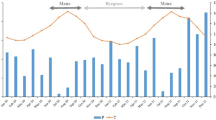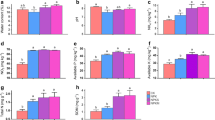Abstract
Organic matter (OM) management is key to sustainable fertility and productivity of tropical soil systems. Short-term evaluation of the potentialsof foliage of neem and locust bean in soil fertility improvement, as measured by the productivity of maize, was carried out on a savanna Alfisol from 1995 to1997. The trees are indigenous to the savanna, and common in farms and homesteads in the region. The objective was to determine the effects of theseeasily renewable and cheap OM sources on maize response to applied inorganic fertilizer and soil chemical properties. Treatments consisted of three sourcesof organic matter: no-OM, neem and locust bean, and three rates of inorganic fertilizer, applied at 0, \(\frac{1}{4}\) and \(\frac{1}{2}\) of the recommended rate of120–27–50 NPK for maize, which in addition served as check. Results obtained over the three seasons were consistent, and revealed that neem wassuperior to locust bean by a factor of 2 and also to no-OM treatments, but were all inferior to the recommended fertilizer rate (with a maximum yield of 3.75t/ha). Isolated relative effects for neem and locust bean only in the third year were 138% and 86% respectively, and declined progressively withincreasing levels of applied inorganic fertilizer. This trend was consistent for the three years, during which soil productivity (relativity index) clearlyappreciated. Results also revealed that P and organic C accumulation was greater with locust bean, but neem decomposed faster and depressed pH less, a clearindication that indices of soil productivity may not always be tied to OM or absolute values of soil properties alone in savanna soil systems. The studyalso revealed that the effects of the tree foliages, the inorganic fertilizer rates and the interactions were significant at various levels of probability forgrain, stover, plant height, available P, OM and pH. There was the possibility of better crop performance with combinations of OM and inorganic fertilizer levels for the soils. Integrated fertility management systems using 3 tons of neem foliage and \(\frac{1}{2}\) recommended inorganic fertilizer rate produced a goodmaize crop, and offers an economically viable option for the resource poor maize farmers of the Nigerian savanna.
Similar content being viewed by others
References
Balasubramanian V. and Nnadi L.A. 1980. Crop residue management and soil productivity in savanna areas of Nigeria. FAO Soil Bulletin 43: 106–120.
Davies R.I., Coulson C.B. and Lewis D.A. 1964. Polyphenols in plant, humus and soil. III. Stabilization of gelatin by polyphenol tanning. J. Soil Sci. 15: 299–309.
Harpstead M.J. 1973. A classification of some Nigerian soils. Soil Sci. 116: 437–443.
Jones M.J. 1976. Effect of three N fertilizers and lime on pH and exchangeable cation content at different depths in cropped soils at two sites of the Nigerian Savanna. Tropical Agriculture 53: 243–254.
Kang B.T. and Spain K.M. 1986. Management of low activity clays with special reference to Alfisols, Ultosols, and Oxisols in the tropics. Proceedings of the Symposium on Low Activity Clay (LAC) Soils. Washington, DC, USA, pp. 107–131.
Klinkenberg K. and Higgins G.M. 1968. An outline of Northern Nigerian soils. Nigerian J. of Science 2: 91–115.
Maydell H.-J. 1986. Trees and shrubs of the sahel: their characteristics and uses. GTZ, Eschborn. 525.
Melillo J.M., Aber D.J. and Muratore J.F. 1982. Nitrogen and lignin control of hard wood leaf litter decomposition dynamics. Ecology. 63: 621–626.
Murphy J. and Riley J.P. 1962. A modified single solution for the determination of phosphate in natural waters. Anal. Chem. Acta. 27: 31–36.
Page A.L., Miller R.H. and Keeney D.R. 1982. Chemical and microbiological properties Methods of Soil Analysis. Amer. Soc. Of Agronomy, USA Part 2.
Palm C.A. and Sanchez P.A. 1991. Nitrogen release from leaves of some tropical legumes as affected by their lignin and polyphenol contents. Soil Biol. And Biochem. 15: 413–418.
Tian G., Kang B.T. and Brussaard L. 1992a. Biological effects of plant residues with contrasting chemical composition under humid tropical conditions — Decomposition and nutrient release. Soil Biology and Biochemistry 24: 1051–1060.
Tian G., Kang B.T. and Brussaard L. 1992b. Mulching effect of plant residues with chemically contrasting composition on maize growth and nutrient accumulation. Plant and Soil 153: 179–187.
Sanchez P.A. and Salinas J.G. 1981. Low input technology for managing Oxisols and Ultisols in tropical America. Advances in Agronomy 34: 279–306.
Author information
Authors and Affiliations
Rights and permissions
About this article
Cite this article
Uyovbisere, E., Elemo, K. Effect of tree foliage of locust bean (Parkia biglobosa) and neem (Azadirachta indica) on soil fertility and productivity of maize in a savanna alfisol. Nutrient Cycling in Agroecosystems 62, 115–122 (2002). https://doi.org/10.1023/A:1015590823039
Issue Date:
DOI: https://doi.org/10.1023/A:1015590823039




